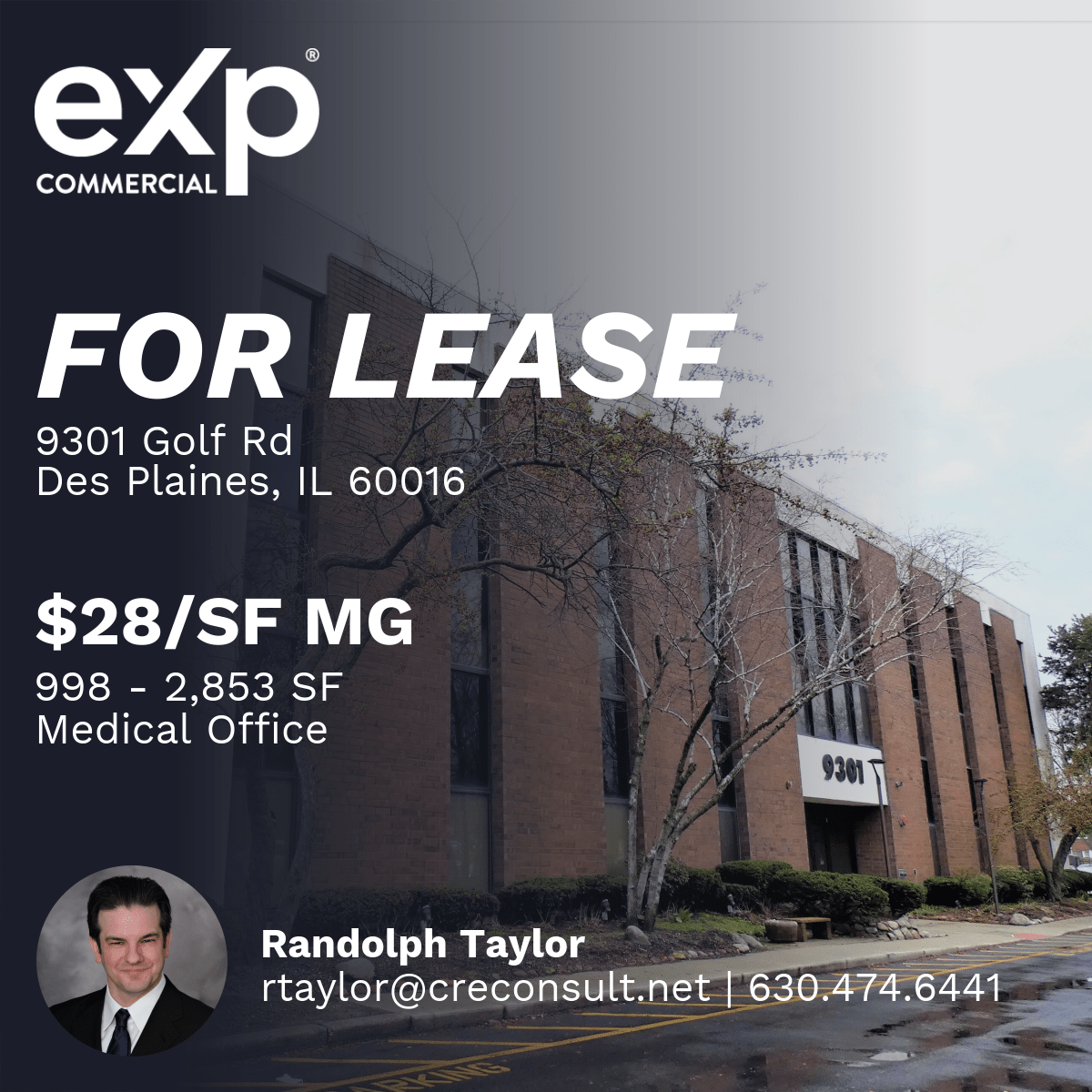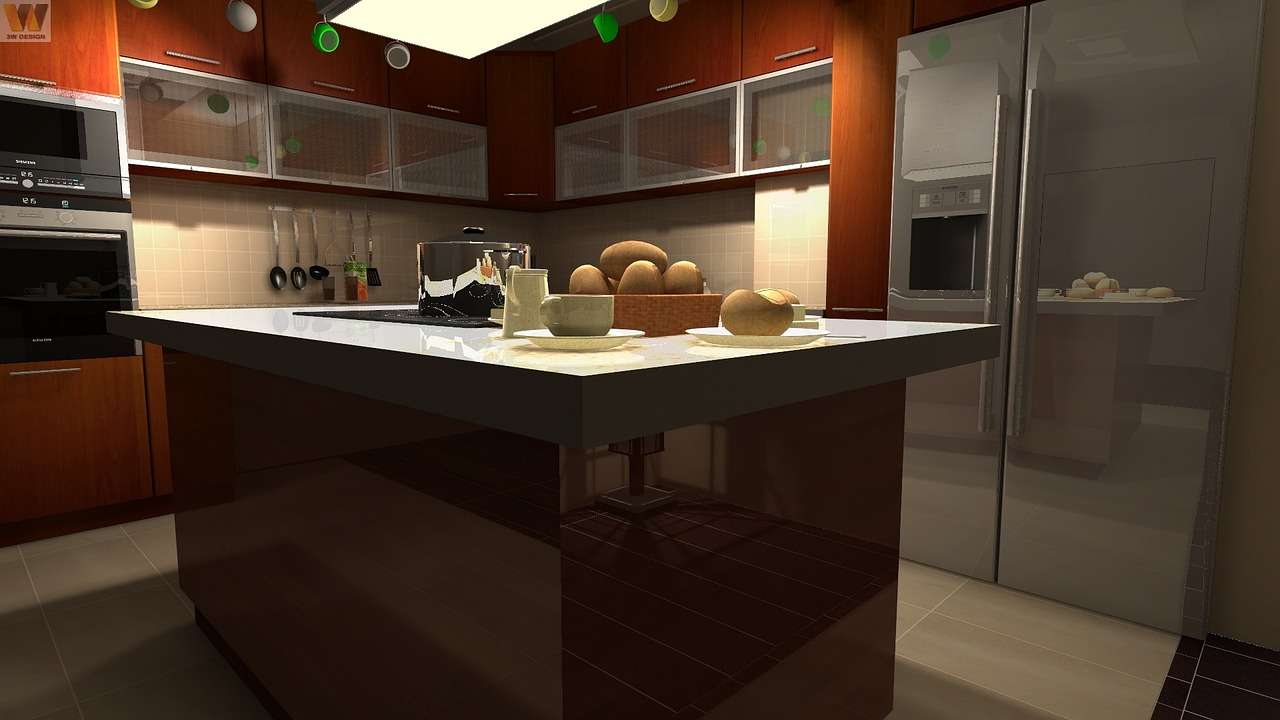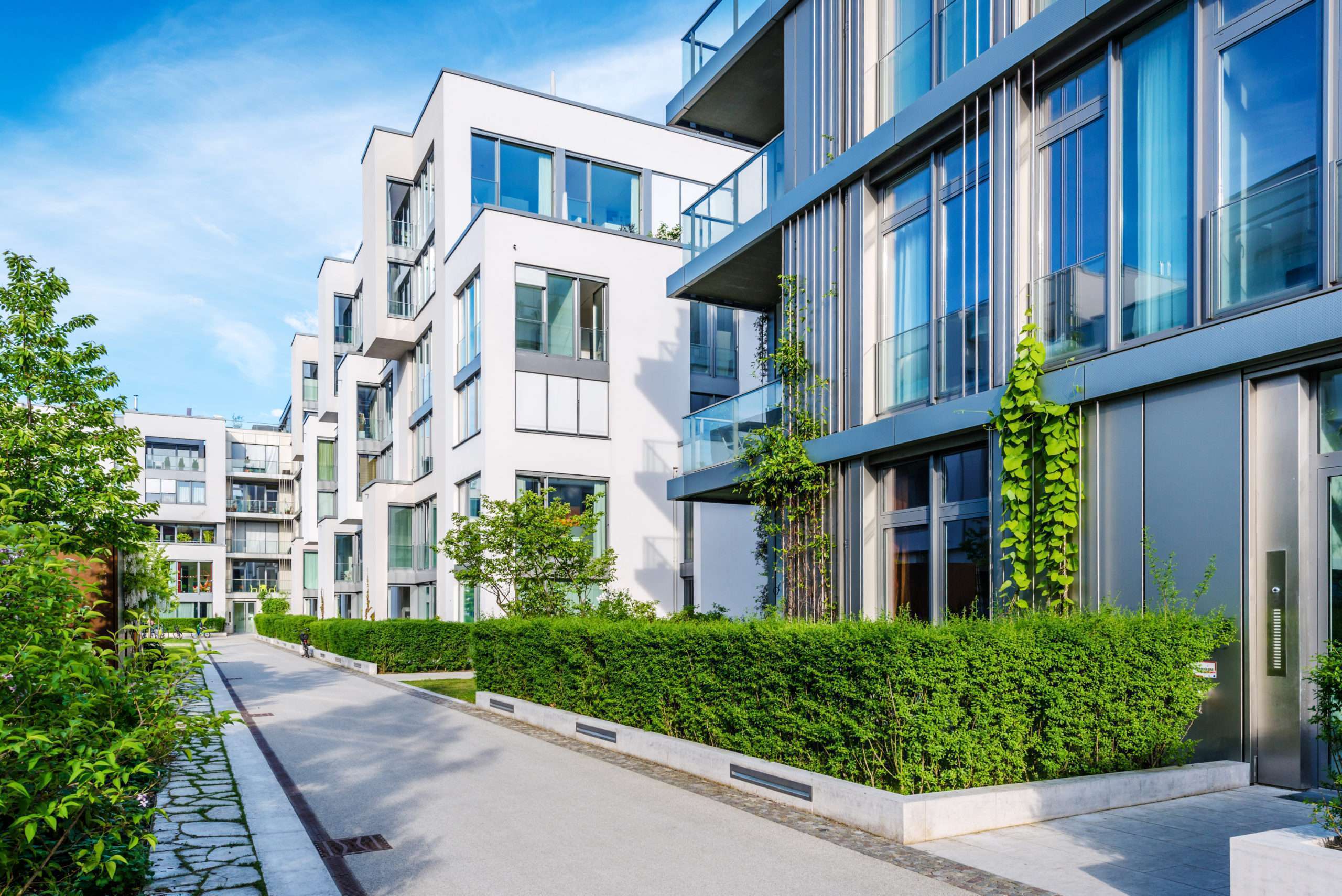9301 West Golf Rd | Des Plaines, IL 60016
Broker: Randolph Taylor rtaylor@creconsult.net | 630.474.6441
https://www.creconsult.net/golf-sumac-professional-building-medical-office-space-for-lease-9301-golf-rd-des-plaines-il-60016/

eXp Commercial is one of the fastest-growing national commercial real estate brokerage firms. The Chicago Multifamily Brokerage Division focuses on listing and selling multifamily properties throughout the Chicago Area and Suburbs.


The Future of Multifamily is Now
Here are three fascinating current trends in multifamily housing that are dramatically changing the rental market as we know it:
1. Build-To-Rent (BTR) Single-Family Homes Are Bringing Privacy and Backyards to Renters
The development of new, single-family homes specifically built for the purpose of renting is a trend that Forbes says is “hot and getting hotter by the minute.” According to RentCafe, Build-To-Rent homes are desirable because “the trend combines the financial and leasing flexibility of a rental with the amenities and convenience of a professionally managed property, all while living a single-family home lifestyle.”
Built-To-Rent single-family homes have wide appeal. Renters of all demographics are tempted by more space and privacy than can be found in a typical multifamily community. Many would-be-homeowners may not be in a position to purchase a home, thanks to skyrocketing home prices which are outpacing wage growth. Inflation and rising interest rates compound the affordability challenge. Build-To-Rent has found its sweet spot, according to Forbes: at “the intersection of desire for a home and economic reality.”
That explains why single-family rental home construction is going gangbusters all across the country. 2021 was a record year with 6,740 new Build-To-Rent homes completed. 2022 promises to be even stronger with nearly 14,000 Build-To-Rent homes under construction as of January, according to RentCafe’s analysis of Yardi Matrix data.
GlobeSt reports that Build-To-Rent is becoming more important to institutional investors and has in fact outperformed traditional multifamily for the past five years. Says Paul Fiorilla of Yardi Matrix, “With so much capital looking to invest in the sector, and the demand for rentals rising, build-to-rents are likely to increase rapidly for the next several years, if not longer.” It appears this housing trend will play an outsize role in the future of the rental housing industry for years to come.
2. Co-Living Arrangements Are Making Space-Sharing Glamorous
The term co-living might conjure up housing arrangements that are less than desirable for most adults, such as cramped college dorms, youth hostels, and co-ops. But the concept of co-living is experiencing what some refer to as a glow-up: it’s gotten better over time.
What is co-living, exactly? According to SALTO, “co-living is when a group of three or more unrelated people live together in one place.” The concept has evolved dramatically in recent years and come to include a wide variety of living arrangements which are much more attractive than shared spaces of old. Says CBRE, modern co-living properties are much like student housing for young professionals. The purpose-built or renovated multifamily assets are designed around several unrelated individuals sharing an apartment unit, sometimes referred to as a ‘pod.’”
The concept of co-living is gaining in popularity for several reasons, including:
Co-living is another rental housing trend that appears to be both heating up—and here to stay. CBRE reports that “co-living companies plan to open more than 55,000 beds in the next few years and have raised hundreds of millions of dollars of equity to meet their expansion targets.” According to Vox, major co-living companies include Common, Ollie, Quarters, Startcity, X Social Communities, and WeLive, which is run by the co-working company WeWork.
3. Flexible, Short-Term Vacation Rentals Are Easier to Manage
Speaking of the shared economy, another trend we are watching in the multifamily space is how renters, owner/operators, and technology companies are innovating to get in on the unsatiable demand for short-term vacation rentals. This has been a volatile space for rental housing, with many owners’ policies and leases as well as local zoning laws regulating or even forbidding short-term vacation rentals. Despite that, PropModo reported at the beginning of 2021 that 65% of recent Airbnb bookings were in multifamily buildings—and home rentals have outperformed hotels in 27 global markets since the start of the pandemic. Clearly the appetite for short term rentals is healthy.
The vacation rental’s most well-known player, Airbnb, has deployed various solutions in an effort to capture a slice of the multifamily rental market as vacation rentals—some more successful than others. For example, the company’s “Airbnb-friendly building program” was put on the back burner in March 2020 according to Rental Scaleup.
In June of 2021, multifamily software and data analytics provider RealPage announced an exclusive partnership with Airbnb to launch an apartment home sharing solution called Migo. According to a RealPage press release on the launch, “residents can recoup a portion of their monthly rent depending upon how frequently they home share exclusively on Airbnb. Owner can differentiate their apartment offering and share the financial benefits of home sharing with residents.”
Benefits of offering home sharing as an amenity for rental housing communities include:
Home sharing may not be suitable for all communities. It is most desirable and practical in urban core areas with high walkability. Newer communities equipped with smart access technologies are particularly well-suited to home sharing.
The pandemic caused a shift in the way people live, work, and travel. Many who formerly reported to an office setting daily have transitioned to hybrid work or permanent work-from-home arrangements, allowing more time and freedom to travel. According to Forbes, “with more people working remotely now, renters can travel more and not risk losing as much money on rent. It could increase listings (on Airbnb) quite substantially, with close to 50 million rental units in the U.S. alone.”
We’ll be closely watching to see how successful rental housing owner/managers are at participating in the vacation rental economy. It seems evident that home sharing is here to stay; what’s less clear is how adept multifamily operators will be at managing the demand and accompanying challenges of short-term rentals.
-------------------------------
It’s true that the future of multifamily may not look quite like the setting of The Jetsons. For example, we have yet to see a rental housing community with conveyer belts that take residents from point A to point B. We’re also still awaiting the flying car that folds itself into a suitcase, no garage required. Developers have not mastered the 1,000-unit community on stilts concept just yet, and while multi-use real estate is all the rage, we’re still watching for the first rental property to feature a floating shopping mall.
Nonetheless, today’s reality for owners and managers of rental housing is evolving rapidly, and we’re excited about the rapid pace of innovation and the potential that comes with it.
Source: The Future of Multifamily is Now
https://www.creconsult.net/market-trends/the-future-of-multifamily-is-now/
What is the Full Property Life Cycle?
Technology has taken multifamily by storm, yet the adoption of advanced solutions remains behind the curve on the maintenance side of operations. Some operators have finally replaced paper work orders and make-ready white boards with an online service request platform, but many continue to relegate other aspects of the physical property life cycle to antiquated methods.
Service request platforms and maintenance workflow solutions have proven invaluable in the day-to-day management of apartment communities, streamlining the process and eliminating much of the opportunity for human error. However, physical care for a property extends far beyond routine resident work orders. Given the current hiring and retention challenges among multifamily maintenance teams, the efficiencies afforded by technology are required across the board.
The industry must take a hard look at opportunities to empower maintenance teams with solutions built to save time, preserve properties, enhance data collection and increase asset value. There are several points in the property life cycle where operators can deploy solutions to support their teams.
Due Diligence
Comprehensive property inspections are a critical component to assessing the viability of value-add programs, making in-depth due diligence efforts paramount to asset success. Historically, this process has involved paper inspection forms. As with any paperwork system, forms vary due to inspector subjectivity and carry an increased potential for human error. Leading operators have switched to digital, mobile inspection forms that guide inspectors through the process. Customizable digital inspection templates create consistency in the process, as well as immediately accessible data, saving time and improving decision-making.
Procurement
Supply chain issues and increased material costs have created significant procurement issues for property teams in recent years. While visibility into the supply chain remains strained in areas, digital maintenance and inspection platforms reduce pain points associated with the procurement process. For example, using procurement technology, technicians can enter parts and materials needs from the field and link them to specific homes, common areas or amenities. This complete visibility is critical for budgeting purposes and keeps teams organized. Such platforms will soon feature the ability to search parts catalogs and source materials from the field, expediting repair times. They also allow maintenance teams to proactively order parts, appliances and materials in advance to ensure they are on hand when needed.
Asset Tracking
Digital asset tracking systems allow operators to keep a pulse on their communities by logging all property assets, from refrigerators to light bulbs. Searchable asset archives provide the status of warranties, anticipated appliance lifespans, asset replacement histories and backstock inventory, creating a database that bolsters budgeting and efficiency, and takes the guesswork out of property upkeep.
Preventive Maintenance
With everything maintenance teams have on their plates, preventive maintenance often slips through the cracks. In addition to managing the day-to-day duties for maintenance teams, workflow platforms allow operators to schedule preventive maintenance tasks and stave off potential property issues before they occur. A well-executed preventive maintenance program can save a community thousands of dollars simply by averting large-scale maintenance issues. When added to the regular workflow schedule, operators have better oversight of preventative maintenance practices, creating a trackable work history on major property infrastructure and establishing documentation for insurance and compliance verification.
Inspections
No property team looks forward to annual inspections, but the process is shortened and made less painful with the use of digital inspection templates customized for each asset. Also, operators can ensure compliance with a comprehensive inspection platform that requires necessary boxes to be checked. The instant and easily accessible reporting provided through digital inspection platforms also makes it simple for operators to identify and address property needs. It provides transparency at all levels of the organization, keeping everyone informed in real-time.
Disposition
By maintaining electronic documentation throughout an asset’s life cycle, including inspection records, preventive maintenance reports, daily maintenance logs and a comprehensive list of physical assets, the property is well positioned for disposition. When buyers are provided with factual information on the physical status of the property, as well as its maintenance history, it saves them time during their own due diligence process and poises the seller to realize the full value upon sale.
Smart technology solutions exist to support the community upkeep efforts of on-site teams. Maintenance and inspection teams are the first lines of defense against physical property issues, and they shouldn’t be the last to be equipped with the technology needed to do their jobs efficiently and effectively. Digital platforms go beyond saving time and expense by streamlining the routine maintenance workflow. When maximized, they improve budgeting, procurement, troubleshooting, tracking and reporting, reducing overall operating costs and preserving assets in the long run. By taking a holistic approach and empowering teams with comprehensive solutions that account for asset needs throughout the property life cycle, management companies can establish an operational advantage across their portfolios that will benefit them for years to come.
Source: What is the Full Property Life Cycle?
https://www.creconsult.net/market-trends/what-is-the-full-property-life-cycle/ [row]
[col span__sm="12"]
[row]
[col span__sm="12"]
These are the average of the top competitive rates from the eXp Commercial's National Capital Markets Partner CommLoan from a database of 700+ commercial lenders as of 5/16/23.
*Actual rates are dependent on property and sponsor and are provided for comparison purposes only.
[/col] [/row] https://www.creconsult.net/market-trends/commercial-real-estate-financing-rates-update-may-16th-2023/
Property improvements and upgrades can be expensive. And, it is easy to over-improve. I’ve been guilty of it several times. But, over the years, I’ve learned a few key practices and thought processes to maximize the return on your property upgrades and to help you select the improvements that will become a profit center and not just a cost. With that in mind, here are a few things to consider…
Know Your Market. A word of caution, before you start, you need to do your homework. The location of your property, the people working in the area, and the nearby amenities will all help determine what the right features should be for your property. You don’t want to waste your money on amenities that don’t add value to your tenant demographic or that won’t get used.
Not everyone wants or needs a dog walking area or a bike room. Survey your current residents for what upgrades they want – or, if you think you will be changing your tenant profile, determine your target demographic, and look to what the newer properties are offering to that market. You might be surprised at what features and amenities are priorities to your target market.
Go For a ‘Wow’ Feature. Make your property stand out. One of the first goals in adding value is to differentiate your property. Your goal is to create something at your property that the prospect wants, but that they can’t get anywhere else – at least not in your price range. This might mean, for example, creating a large, walk-in closet, complete with a high end closet organizing system versus the other properties that just have a standard closet. If you’re renovating your unit, think about how you can steal space for this. Most units these days are lacking in storage space.
It could be a unique common area amenity like a great BBQ or pool area. It could be unique services that you offer. Even doing a two color paint job vs. one color in the units can make a difference. Maybe your future residents get to choose from a palette of colors. Whatever it is, the key is to make your property stand out in the mind of the prospect.
If nothing else, I try to add a few features in the apartment that are ‘one step up’ from what the prospect might expect in comparable priced units. This might mean a nicer appliance, or electrical outlets with USB ports. The key is to be different and better in the mind of the prospect.
Think upgrades that have Operational Benefits. Think improvements like using LED lighting to save on energy bills, or adding a camera system that not only makes residents feel secure, but helps eliminate some of the problems you’ve had at your property. Perhaps upgrading the bath vent fans in the units to ones that are quieter and have stronger air flow. This not only make your tenants happier (to not have that noisy vent fan), but reduces the chance of mold developing. The list goes on and on.
Energy savings is a great area to look at. Smart lighting systems or thermostats not only save money and energy, but also have a ‘cool’ factor (pun intended). How nice would it be for your resident to be able to turn on their air conditioning 30 minutes before getting home. Or, with a smart lock, to be able to let in their guest, even when running late.
I once rented an office at a co-working space. The hallway lighting was motion activated, and monitored what times people tended to be in the offices and when they left. This helped keep the hours that the heat and air conditioning were on to a minimum, while still keeping us, as tenants, comfortable. You can do something similar at your property.
Think Amenities that Bring People Together. Renters today are looking for a sense of community. You want that too – encouraging connection amongst your residents keeps them happier and keeps them longer. That means less turnover for you and a building that becomes more in demand as residents encourage their friends to move to your property as well.
People spend so much time on technology these days, that they are looking for more human interaction in their community. Providing an amenity that aids in the meeting of fellow residents is the type of thing renters are looking for in their living experience.
You might have unused or underutilized outdoor space that could be converted into an area for social gatherings. Common cooking spaces, dog parks, community gardens, or rooftop decks and coffee bars are all places residents can gather to get to know each other. Creating great community amenities that encourage mingling and socializing is a great use of your renovation dollar.
When planning your renovations, always select your projects with intention. When it comes to attracting and keeping quality residents, the amenities and upgrades you choose make a big difference. Residents today are looking for amenities that provide convenience and a sense of community. Your goal is to meet those needs and do what you can to keep them longer. Remember, reducing turnover makes you money in the long run.
A word of caution - Always keep the base level of your competition and the reputation of the neighborhood in mind. People will only look in a certain price range in any given neighborhood. Above that, they go to the ‘next best’ neighborhood to look. I wish you great success in your next renovation.
Source: How to Upgrade Your Property but not Over Improve it
https://www.creconsult.net/market-trends/how-to-upgrade-your-property-but-not-over-improve-it/
There are a number of reasons why people decide to sell their multifamily property, but most can be categorized into three groups: Problems, Opportunities, and Changes.
With this decision though comes the consideration of capital gains tax and how to ensure you are getting the most for the sale of your property.
There are several reasons why people do sell:
Problems:
Opportunities:
Changes:
There are several options for sellers to defer or minimize capital gains taxes:
We not only market properties for sale. We make a market for properties we represent. Each offering is thoroughly underwritten, aggressively priced, and accompanied by loan quotes to expedite the sales process. We leverage our broad national marketing platform syndicating to the top CRE Listing Sites with direct outreach to our investor database and an orchestrated competitive bidding process that yields higher sales prices.
Contact Us to discuss what information is needed to complete a Complimentary Commercial Broker Opinion of Value (BOV).
This is understandable as only about 5% of the market trades in any given year. We are also happy discuss any purchase or refinance interests and recommend some physical and operational changes you can make to add value to your property you will appreciate when you eventually sell.
eXp Commercial Chicago Multifamily Brokerage focuses on listing and selling multifamily properties throughout the Chicago Area and Suburbs.
We don’t just market properties; we make a market for each property we represent. Each offering is thoroughly underwritten, aggressively priced, and accompanied by loan quotes to expedite the sales process. We leverage our broad national marketing platform syndicating to the top CRE Listing Sites for maximum exposure combined with an orchestrated competitive bidding process that yields higher sales prices for your property.
https://www.creconsult.net/market-trends/why-should-i-sell-my-multifamily-property/

Using Data to Drive NOI
Real-time data helps multifamily leaders make better decisions, faster; ultimately being the key to driving NOI. We’re big proponents of using data to show your people what to do next versus telling them what to do. It’s a crucial practice to driving sustained organizational revenue and winning as a team in an industry that lags others in terms of innovative practices.
Here are three actionable use cases that our team presented at the RETCON 2022 Conference to illustrate the NOI power of showing versus telling.
A multifamily client (Asset Manager) was faced with a New York property that was falling short of its occupancy goals despite a relatively high-cost unit marketing spend.
Instead of immediately increasing their marketing spend, they dug into the data and found:
Here’s where the rubber meets the road. Conversion after touring was less than half of other NYC projects. This revealed a few great opportunities:
While it may seem counter-intuitive to reduce Marketing spend while trying to drive more traffic, using the data to play out what-if scenarios (traffic conversion to application, optimizing traffic sources, etc.) allowed the client to focus on key areas to drive efficiency and effectiveness.
Visualization Case - Show Trends
In the first month of a lease-up, another multifamily client (Owner Operator) was reviewing the leasing velocity data of their high-rise development. They started their conversation with a look at the occupancy and availability through their elevation visualization.
This allowed them to visualize current data using 2D, 3D, and geospatial models of their lease-up. Seeing some floorplans/stacks lease more quickly and others more slowly, they found there was something geographically appealing about a particular side of the property.
This revealed a big opportunity:
Data visualization allowed the team to quickly spot this unusual trend and gain clarity around unit-specific nuances that were impacting leasing and NOI.
Renewal Case – Show Variables
We’ve all heard the age-old saying that it costs more to hire a new employee than it does to retain one. Well, the same goes for multifamily, thus the importance of effectively managing renewals, which often make up 50% or more of a property’s NOI.
A multifamily client (Owner Operator) built an analytically driven culture and NOI within their organization by deploying a Renewal Negotiation Dashboard that co-mingles data from different sources so that Community Managers could see all the variables that might play into a resident’s decision to renew their lease or not.
The following data provided all the answers to questions that a resident might raise during a renewal discussion and empowered managers to know the entire lease story for any resident who walked through the door within minutes.
By making this data available, Community Managers across the organization were empowered to gauge when they were in a position of strength to negotiate or weakness.
These are only a few examples of wins that have come out of using data to show versus tell. What could your data be showing you? How could you be using data to lead your teams to faster and better decisions? Is your data hindering or driving your NOI?
Source: Show Don’t Tell – Using Data to Drive NOI
https://www.creconsult.net/market-trends/show-dont-tell-using-data-to-drive-noi/Chicago apartment market 2025 is one of the most competitive rental environments in the country. Anyone who’s ever tried to find a two-bedr...
